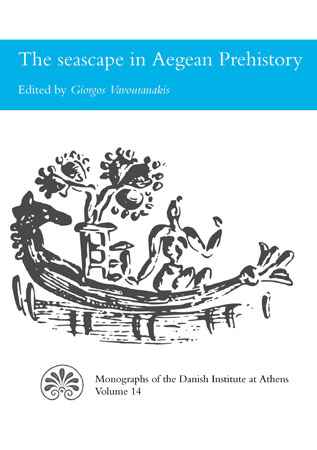The Seascape in Aegean Prehistory
Giorgos Vavouranakis (επιμέλεια)

Πόλη: Αθήνα
Έτος: 2011
Εκδότης: The Danish Institute at Athens
Σειρά: Monographs of the Danish Institute at Athens, vol. 14
Περιγραφή: Σκληρό εξώφυλλο, 288 σ., 44 ασπρόμαυρες εικόνες, 3 πίνακες, χάρτες, 28×21,5 εκ.
Περίληψη (από την Εισαγωγή, στα Αγγλικά)
This book is about the relationship between the people and the sea in the prehistoric Aegean. It explores how people understood the sea as an integral part of their way of life and examines the role the sea played in the prehistoric societies of the archipelago. It may at first seem obvious – even selfevident – that there had been a close relationship between people and the sea, since the Aegean Archipelago is the dominant feature of its wider area. It spreads over at total area of about 214,000 sq km. This is a bit less than the overall land area of Greek state today, which is almost 132,000 sq km. This large area of water includes over 1000 islands, many of which are populated today. The Aegean Sea and its islands epitomise Greece in the minds of many people today.
Nonetheless, we should remember that the land that borders the Aegean features the important mountain range of Pindos, the plains of Thessaly and Macedonia and, next to Greece, Turkey, with the solid landmass of Asia Minor. These places have always accommodated extensive and flourishing communities that were not related to the sea at all. Furthermore, many people on Mt Ida in Crete had never seen the sea in the recent past, despite being on an island, while until recently many Greeks living close to the coast had not known how to swim. A maritime way of life may be an obvious option, but it is neither the only nor an inevitable one in the Aegean. There is always room for choice in the relation between people and the sea and this relation may acquire various forms and different degrees of intimacy.
Περιεχόμενα
List of contributors [9]
Giorgos Vavouranakis, ‘Preface’ [11-12]
Giorgos Vavouranakis, ‘Introduction’ [13-29]
Albert J. Ammerman, ‘The paradox of early voyaging in the Mediterranean and the slowness of the Neolithic transition between Cyprus and Italy’ [31-49]
Tatiana Theodoropoulou, ‘Fishing (in) Aegean seascapes: early Aegean fishermen and their world’ [51-69]
Despina Catapoti, ‘Further thoughts on the International Spirit: maritime politics and consuming bodies in the early Cyclades’ [71-89]
Giorgos Vavouranakis, ‘Funerary customs and maritime activity in Early Bronze Crete’ [91-118]
Ina Berg, ‘Towards a conceptualisation of the sea: artefacts, iconography and meaning’ [119-137]
Matthew Haysom, ‘Fish and ships: Neopalatial seascapes in context’ [139- 160]
John G Younger, ‘A view from the sea’ [161-183]
Vassilis P. Petrakis, ‘Politics of the sea in the Late Bronze Age II-III Aegean: iconographic preferences and textual perspectives’ [185-234]
Sophia Antoniadou, ‘Import-ant Aegeans in Cyprus: a study on Aegean imports in Late Bronze Age non-mortuary contexts in Cyprus’ [235-249]
Anastasia Leriou, ‘Overseas migrations at the end of the Late Bronze Age in the Aegean and the eastern Mediterranean: some reflections’ [251-270]
Kostas Kotsakis, ‘An epilogue: histories from the sea’ [271-281]
Index [283-288]

Σχόλια
Παρακαλούμε τα σχόλιά σας να είναι στα Ελληνικά (πάντα με ελληνικούς χαρακτήρες) ή στα Αγγλικά. Αποφύγετε τα κεφαλαία γράμματα. Ο Αιγεύς διατηρεί το δικαίωμα να διαγράφει εκτός θέματος, προσβλητικά, ανώνυμα σχόλια ή κείμενα σε greeklish.